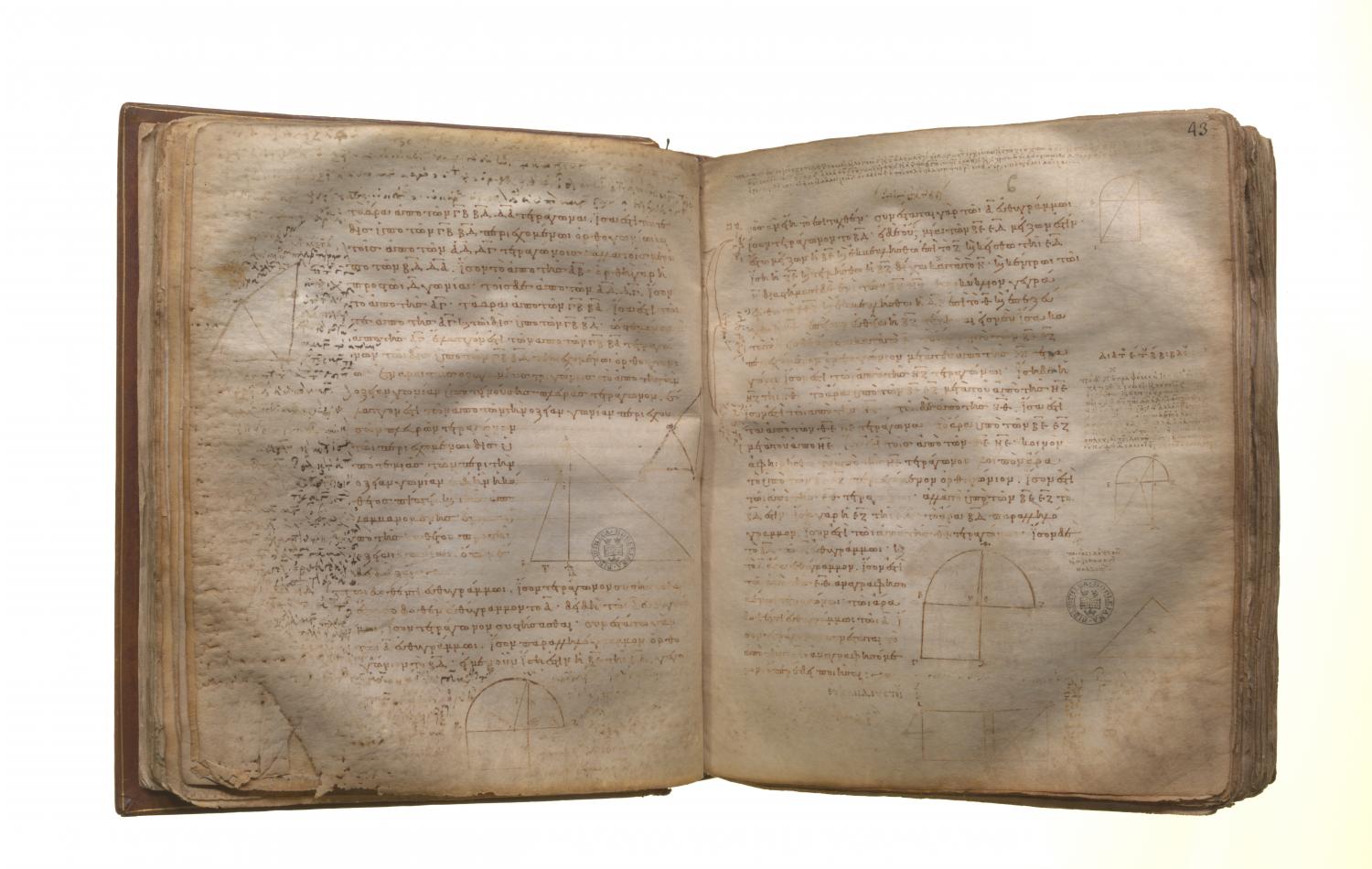Ἐν τοῖς ὀξυγωνίοις τριγώνοις τὸ ἀπὸ τῆς τὴν ὀξεῖαν γωνίαν ὑποτεινούσης πλευρᾶς τετράγωνον ἔλαττόν ἐστι τῶν ἀπὸ τῶν τὴν ὀξεῖαν γωνίαν περιεχουσῶν πλευρῶν τετραγώνων τῷ περιεχομένῳ δὶς ὑπό τε μιᾶς τῶν περὶ τὴν ὀξεῖαν γωνίαν, ἐφ' ἣν ἡ κάθετος πίπτει, καὶ τῆς ἀπολαμβανομένης ἐντὸς ὑπὸ τῆς καθέτου πρὸς τῇ ὀξείᾳ γωνίᾳ. Ἔστω ὀξυγώνιον τρίγωνον τὸ ΑΒΓ ὀξεῖαν ἔχον τὴν πρὸς τῷ Β γωνίαν, καὶ ἤχθω ἀπὸ τοῦ Α σημείου ἐπὶ τὴν ΒΓ κάθετος ἡ ΑΔ: λέγω, ὅτι τὸ ἀπὸ τῆς ΑΓ τετράγωνον ἔλαττόν ἐστι τῶν ἀπὸ τῶν ΓΒ, ΒΑ τετραγώνων τῷ δὶς ὑπὸ τῶν ΓΒ, ΒΔ περιεχομένῳ ὀρθογωνίῳ. Ἐπεὶ γὰρ εὐθεῖα ἡ ΓΒ τέτμηται, ὡς ἔτυχεν, κατὰ τὸ Δ, τὰ ἄρα ἀπὸ τῶν ΓΒ, ΒΔ τετράγωνα ἴσα ἐστὶ τῷ τε δὶς ὑπὸ τῶν ΓΒ, ΒΔ περιεχομένῳ ὀρθογωνίῳ καὶ τῷ ἀπὸ τῆς ΔΓ τετραγώνῳ. κοινὸν προσκείσθω τὸ ἀπὸ τῆς ΔΑ τετράγωνον: τὰ ἄρα ἀπὸ τῶν ΓΒ, ΒΔ, ΔΑ τετράγωνα ἴσα ἐστὶ τῷ τε δὶς ὑπὸ τῶν ΓΒ, ΒΔ περιεχομένῳ ὀρθογωνίῳ καὶ τοῖς ἀπὸ τῶν ΑΔ, ΔΓ τετραγώνοις. ἀλλὰ τοῖς μὲν ἀπὸ τῶν ΒΔ, ΔΑ ἴσον τὸ ἀπὸ τῆς ΑΒ: ὀρθὴ γὰρ ἡ πρὸς τῷ Δ γωνίᾳ: τοῖς δὲ ἀπὸ τῶν ΑΔ, ΔΓ ἴσον τὸ ἀπὸ τῆς ΑΓ: τὰ ἄρα ἀπὸ τῶν ΓΒ, ΒΑ ἴσα ἐστὶ τῷ τε ἀπὸ τῆς ΑΓ καὶ τῷ δὶς ὑπὸ τῶν ΓΒ, ΒΔ: ὥστε μόνον τὸ ἀπὸ τῆς ΑΓ ἔλαττόν ἐστι τῶν ἀπὸ τῶν ΓΒ, ΒΑ τετραγώνων τῷ δὶς ὑπὸ τῶν ΓΒ, ΒΔ περιεχομένῳ ὀρθογωνίῳ. Ἐν ἄρα τοῖς ὀξυγωνίοις τριγώνοις τὸ ἀπὸ τῆς τὴν ὀξεῖαν γωνίαν ὑποτεινούσης πλευρᾶς τετράγωνον ἔλαττόν ἐστι τῶν ἀπὸ τῶν τὴν ὀξεῖαν γωνίαν περιεχουσῶν πλευρῶν τετραγώνων τῷ περιεχομένῳ δὶς ὑπό τε μιᾶς τῶν περὶ τὴν ὀξεῖαν γωνίαν, ἐφ' ἣν ἡ κάθετος πίπτει, καὶ τῆς ἀπολαμβανομένης ἐντὸς ὑπὸ τῆς καθέτου πρὸς τῇ ὀξείᾳ γωνίᾳ: ὅπερ ἔδει δεῖξαι.
In acute-angled triangles the square on the side subtending the acute angle is less than the squares on the sides containing the acute angle by twice the rectangle contained by one of the sides about the acute angle, namely that on which the perpendicular falls, and the straight line cut off within by the perpendicular towards the acute angle. Let ABC be an acute-angled triangle having the angle at B acute, and let AD be drawn from the point A perpendicular to BC; I say that the square on AC is less than the squares on CB, BA by twice the rectangle contained by CB, BD. For, since the straight line CB has been cut at random at D, the squares on CB, BD are equal to twice the rectangle contained by CB, BD and the square on DC. [II. 7] Let the square on DA be added to each; therefore the squares on CB, BD, DA are equal to twice the rectangle contained by CB, BD and the squares on AD, DC. But the square on AB is equal to the squares on BD, DA, for the angle at D is right; [I. 47] and the square on AC is equal to the squares on AD, DC; therefore the squares on CB, BA are equal to the square on AC and twice the rectangle CB, BD, so that the square on AC alone is less than the squares on CB, BA by twice the rectangle contained by CB, BD.

